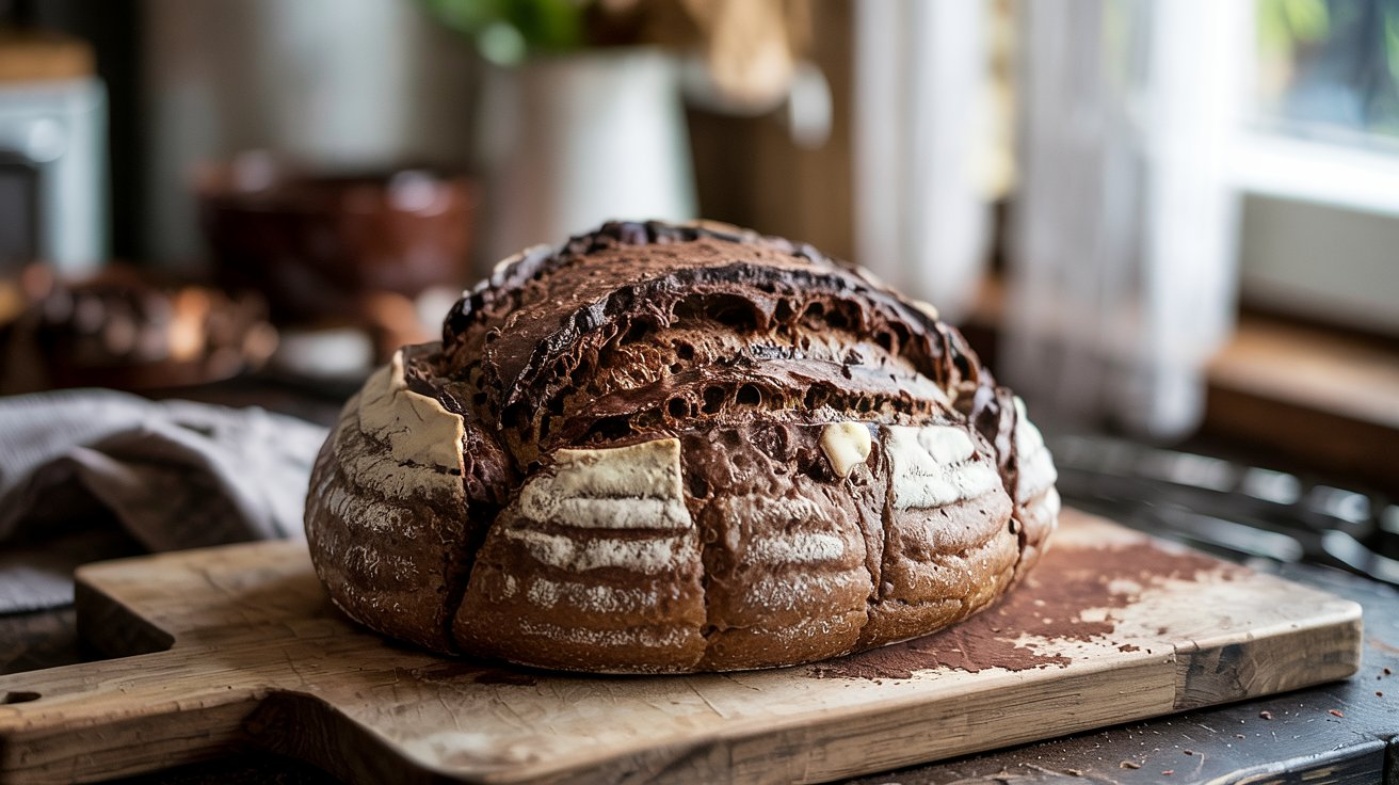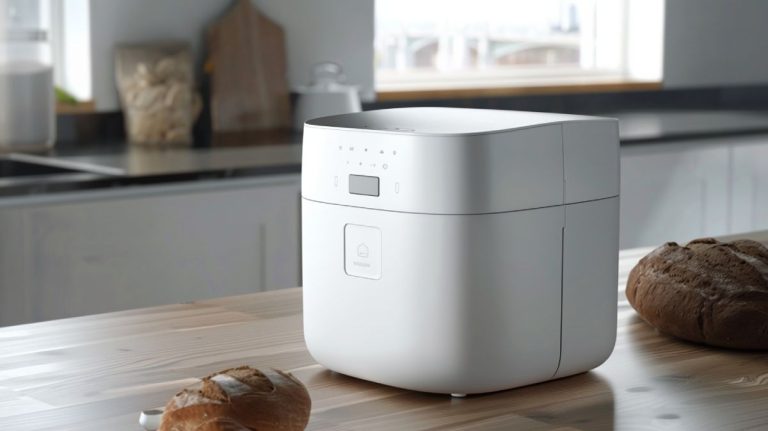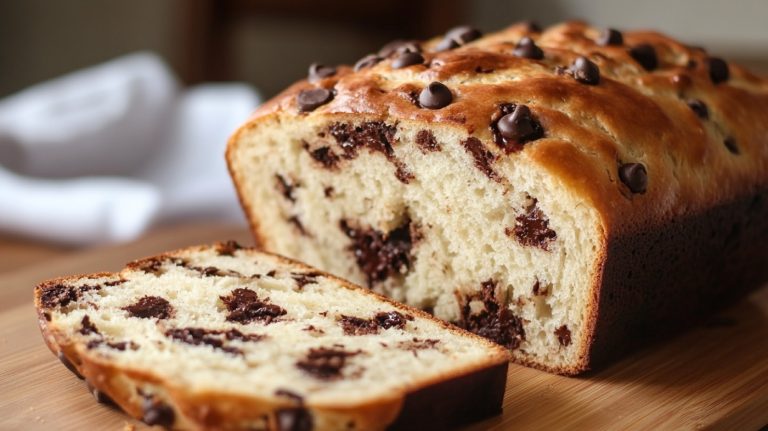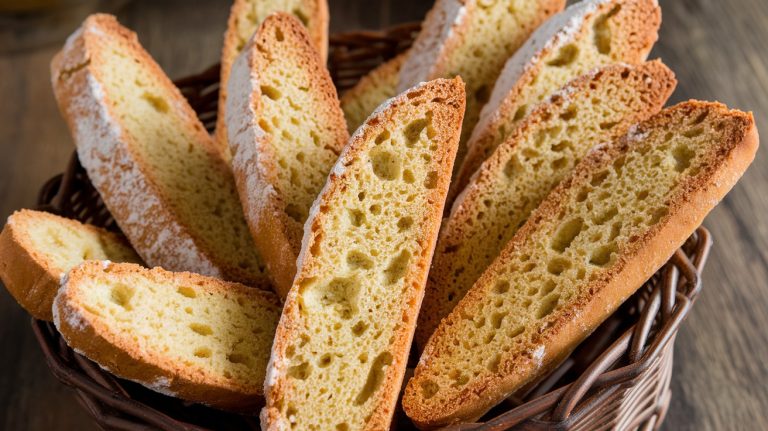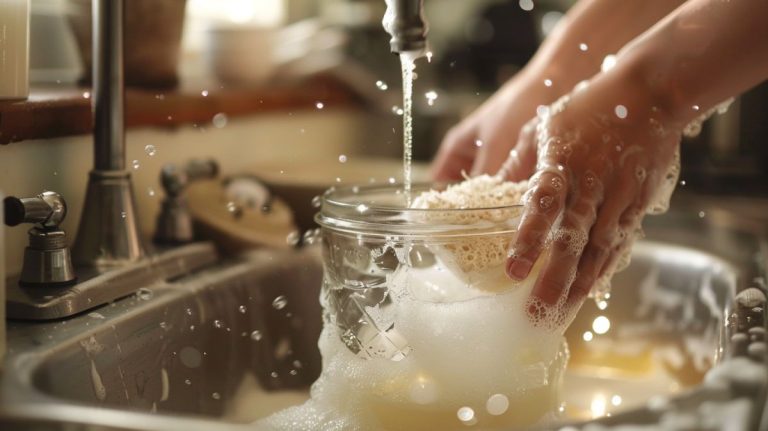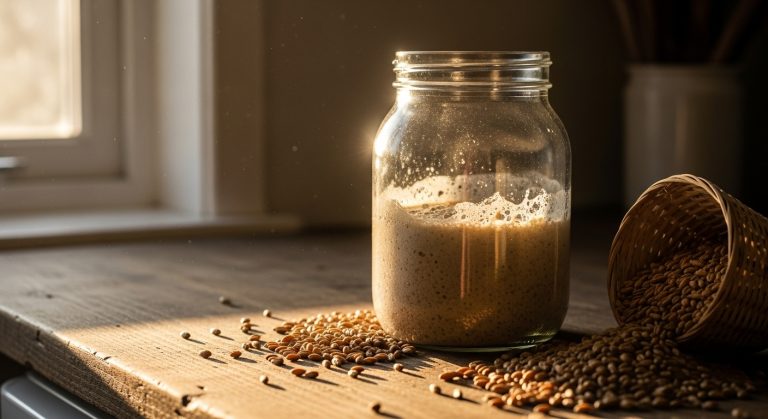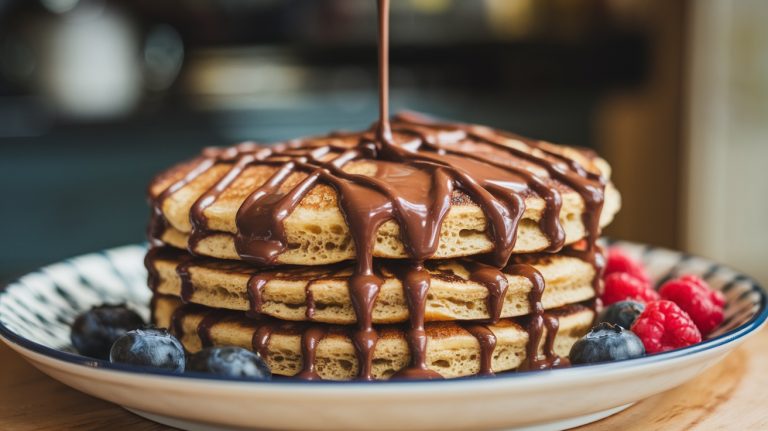Double Chocolate Espresso Sourdough Bread: A Delicious Masterpiece
Jump into crafting Double Chocolate Espresso Sourdough Bread with a tangy, bold twist! Mix your active sourdough starter with flour, water, and a touch of sweetness. Blend in rich cocoa powder and espresso powder for deep, earthy notes.
Fold in decadent dark chocolate chunks for melty bliss. Bake in a hot Dutch oven for a crisp crust and tender crumb. Stick around to uncover every secret behind this indulgent loaf.
Key Takeaways
- Combine active sourdough starter, cocoa powder, and espresso powder for a rich, tangy Double Chocolate Espresso Sourdough Bread.
- Use 100-180g dark chocolate chunks, folded into dough during stretch and fold for even distribution.
- Add 1-2 tsp espresso powder with dry ingredients to enhance chocolate depth without altering hydration.
- Ferment at 75-82°F, watching for 30-50% rise, adjusting hydration if cocoa stiffens dough.
- Bake in preheated Dutch oven at 450-500°F, cooling fully on rack for best texture.
Essential Ingredients for Chocolate Bliss
Get ready to craft a masterpiece with the key chocolate components—think rich cocoa powder and decadent chips or chunks—that’ll make your Double Chocolate Espresso Sourdough Bread utterly irresistible.
Your sourdough starter’s tangy magic is essential, balancing the sweetness while adding depth to every bite. This sourdough discard also ensures a tender, fluffy texture by providing necessary moisture.
And don’t skimp on the espresso; its bold, roasted kick amplifies the chocolate’s intensity, creating a flavor explosion you can’t resist.
This bread’s indulgent nature, with chunks of chocolate scattered throughout, elevates every slice to a luxurious treat.
Key Chocolate Components
Dive into the heart of chocolate ecstasy with the essential components that make Double Chocolate Espresso Sourdough Bread a true indulgence.
You’re crafting a masterpiece, so choose high-quality cocoa powder for that deep, intense flavor.
Then, grab premium dark chocolate chunks; their rich, velvety melt will stud your loaf with decadence.
Elevate your creation with these key chocolate elements:
- Cocoa Powder: Opt for unsweetened, Dutch-processed for a smooth, robust base.
- Dark Chocolate Chunks: Select 70% cacao or higher for bold bitterness.
- Cocoa Nibs: Sprinkle in for a crunchy, pure chocolate punch.
- Chocolate Extract: A dash intensifies the aroma, binding all flavors.
Sourdough Starter Role
A vibrant sourdough starter is the soul of your Double Chocolate Espresso Sourdough Bread, infusing it with life and unparalleled depth. You’re nurturing a living culture of wild yeast and lactic acid bacteria, which ferments to create an airy, chewy texture and tangy complexity.
Feed it regularly with flour and water to keep it thriving—it’s your natural leavening agent, producing CO2 to make the dough rise. Consistent feeding schedules are crucial to maintain its strength consistent feeding schedules.
For optimal results in this recipe, consider using a fed starter to enhance the dough’s activity and achieve a better rise.
Check this table for its essential roles:
| Aspect | Function | Impact on Bread |
|---|---|---|
| Leavening | Produces CO2 via yeast | Airy, spongy texture |
| Flavor | Acids create tanginess | Complex, rich taste |
| Texture | Enzymes soften gluten | Chewy, light crumb |
| Nutrients | Breaks down phytic acid | Better mineral absorption |
| Digestion | Fermentation aids gut health | Easier to digest |
Espresso Flavor Boost
Imagine harnessing the bold intensity of espresso to elevate your Double Chocolate Espresso Sourdough Bread into a world of pure chocolate bliss.
You’re not just adding a coffee kick; you’re deepening chocolate’s complexity with espresso powder’s concentrated punch.
A mere teaspoon balances sweetness, cuts through richness, and amplifies cocoa’s earthy, nutty depths, thanks to shared flavor compounds like pyrazines. This method integrates seamlessly with the stretch and fold technique for optimal gluten development.
Mix it with dry ingredients or bloom it with cocoa in hot water for seamless integration. This technique ensures even flavor distribution throughout your bread.
Unlock this flavor magic with these tips:
- Use 1/2 to 2 teaspoons of espresso powder for subtle intensity.
- Pair with salt and vanilla to enhance chocolate notes.
- Opt for high-quality dark chocolate (56% cacao) for richness.
- Substitute instant coffee if needed, increasing by 50%.
Mixing and Kneading Techniques
Jump right into crafting your Double Chocolate Espresso Sourdough Bread by mastering the mixing and kneading techniques that’ll bring this indulgent loaf to life.
Start by combining flour, water, sourdough starter, cocoa powder, and sweetener in a bowl, mixing until no dry flour remains.
Let it rest for an autolyse to boost hydration, then incorporate salt.
For this high-hydration dough, hold back some water and add it gradually.
Use the stretch and fold technique, doing four folds per set every 30 minutes during early bulk fermentation. This approach, known as stretch and fold, is effective for developing gluten in high-hydration doughs.
Wet your hands to avoid sticking, and gently fold in chocolate chips after the first rest.
Build strength until the dough turns smooth, airy, and jiggly with each passionate stretch.
Enhancing Flavor With Espresso
Now that you’ve mastered the mixing and kneading of your Double Chocolate Espresso Sourdough Bread, let’s amp up the flavor with a bold twist of espresso. This enhancement can also complement the tangy flavor provided by sourdough discard in your bakes.
This powerhouse ingredient intensifies chocolate’s richness with its bittersweet depth, balancing sweetness and enhancing complexity. Even a small amount can elevate chocolate flavor significantly in your baked goods.
Mix a teaspoon of espresso powder with dry ingredients like flour for subtle notes, or dissolve it in warm water before blending with wet components.
Keep brewed espresso cooled to protect your sourdough yeast.
Dive into these flavor-boosting tips:
- Start with 1 tsp of espresso powder for subtle enhancement.
- Increase to taste for a mocha punch.
- Use powder over liquid to maintain dough hydration.
- Cool any brewed espresso to safeguard fermentation.
Incorporating Chocolate Chunks
Chocolate-laden bliss awaits as you incorporate chocolate chunks into your Double Chocolate Espresso Sourdough Bread, transforming each bite into a decadent delight.
Indulge in chocolate-laden bliss with Double Chocolate Espresso Sourdough Bread, where every bite becomes a decadent, irresistible delight.
Opt for semi-sweet or dark chocolate with 60%+ cocoa content for a rich balance against the sourdough’s tang.
Use 100-180g per loaf, or measure with your heart for personal flair.
During the stretch and fold process, sprinkle chunks evenly over the dough, then gently fold them in to achieve uniform distribution.
Stretch the dough into a rectangle, scatter the chocolate, and roll it up tightly.
Dampen your hands to avoid sticking as you work. Don’t fret if chunks tear through slightly—it’s normal.
Aim for even pockets of melty goodness in every slice. This approach can help achieve a tender crumb, enhancing the overall texture of the bread.
Mastering the Fermentation Process
How can you unlock the full potential of your Double Chocolate Espresso Sourdough Bread? It’s all about mastering fermentation!
Start with an active, bubbly starter—feed it 4-12 hours before with a 1:1 ratio and make sure it floats in water. For reliable results, ensure your starter has been fed regularly for at least two weeks, as starter maturity enhances its buoyancy.
During bulk fermentation, aim for a 75-82°F (24-28°C) environment to control the pace, knowing cocoa and sugar might slow things down.
Watch for a 30-50% rise, a smooth surface, and a slight jiggle. Be patient, as the fermentation process can teach valuable life lessons through its slow, transformative nature.
Here’s how to nail it:
- Check your starter’s readiness with the float test.
- Maintain ideal temperature for consistent fermentation.
- Look for visual cues like bubbles and a domed surface.
- Adjust hydration if cocoa stiffens the dough.
Shaping and Proofing Tips
Dive into the art of shaping and proofing your Double Chocolate Espresso Sourdough Bread with finesse! Handle the sticky, cocoa-stiffened dough with wet hands to prevent clinging, and use a wet bench scraper if it’s too tacky. To enhance the non-stick properties, dust the banneton with rice flour.
Pre-shape into a rough boule or batard, let it rest 15-30 minutes, then fold and drag to build tension, tucking chocolate chips inside to avoid surface exposure. For optimal results, create tension by pulling the dough toward all sides with your hands.
Place it seam-side up in a well-floured banneton—rice flour works wonders.
Cold-proof in the fridge for 8-48 hours; the chocolate and sugar may slow fermentation, so watch for a puffed, airy look.
Use the poke test: a slow spring-back with a slight indent means it’s perfectly proofed and ready for the next step!
Baking for Optimal Crust and Crumb
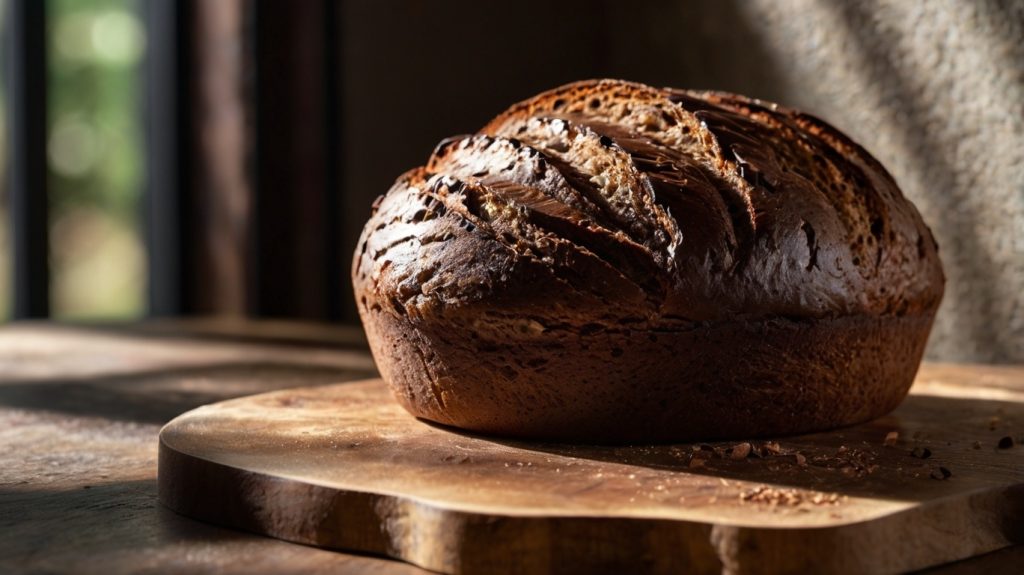
When baking your Double Chocolate Espresso Sourdough Bread, start by preheating your Dutch oven to a scorching 500°F (260°C) to lock in that intense heat for a stellar crust. You’ll want to harness steam by keeping the lid on for the first 20 minutes, ensuring the dough’s surface stays moist for maximum oven spring and a glossy, crisp finish.
Trust me, this combo of searing heat and trapped moisture is your secret weapon for a crust that crackles with every bite! For an even thinner crust, consider extending the steam time to 30-35 minutes to delay crust hardening during the initial baking phase.
Preheating Dutch Oven
Ignite your baking prowess by mastering the art of preheating your Dutch oven, an essential step in crafting the perfect Double Chocolate Espresso Sourdough Bread.
You’ve gotta heat it to 450°F-500°F (230°C-260°C) for at least 30 minutes, ensuring the cast iron’s thermal mass creates a stable, intense environment.
This mimics professional ovens, maximizing oven spring for an airy crumb and setting the stage for a stunning crust with deep color and flavor.
Don’t rush—verify the pot’s heat with an infrared thermometer if needed. Remember, preheating together with the dough inside can be an alternative, as it eliminates preheating challenges and ensures a seamless transition to baking.
Key tips for perfection:
- Preheat for 30-60 minutes for even heat distribution.
- Avoid exceeding 500°F to prevent crust from setting too fast.
- Adjust to 425°F if the bottom burns.
- Place cold dough in for ideal rise.
Steam for Crust
How can you achieve that irresistible, glossy crust on your Double Chocolate Espresso Sourdough Bread? It’s all about steam! When you load your cold dough into a scorching oven, introduce steam immediately to keep the crust moist and flexible. This delays hardening, letting your loaf expand fully for epic oven spring.
Use a Dutch oven to trap the dough’s moisture, or place a preheated cast iron pan with boiling water on a lower rack for a burst of steam. Focus on the first 20 minutes, as steam gelatinizes surface starches for that shiny finish and promotes a crisp, golden crust. Additionally, steam mimics the conditions of professional ovens, ensuring optimal crust coloration. After this, vent the steam to dry and crisp up your bread’s exterior perfectly!
Cooling and Slicing Guidelines
After pulling your Double Chocolate Espresso Sourdough Bread from the oven, don’t underestimate the importance of cooling—it’s the essential final step in your baking journey.
Place your loaf on a wire rack immediately to let air circulate, preventing a soggy crust.
Don’t cover it; trapped steam ruins that crisp exterior.
Let it cool 2-4 hours—or longer for this enriched loaf—to guarantee the crumb sets and flavors deepen.
Slicing too soon yields gummy, uneven slices, so patience is key. As the bread cools, the interior starch recrystallizes, firming the crumb.
Here’s how to perfect the process:
- Wait: Cool completely to avoid a collapsed structure.
- Use a serrated knife: Slice with a gentle sawing motion.
- Start with a groove: Prevent slipping on the crust.
- Hold gently: Avoid crushing your masterpiece.
Creative Serving Suggestions
Why settle for ordinary when your Double Chocolate Espresso Sourdough Bread can steal the show?
Why choose the everyday when your Double Chocolate Espresso Sourdough Bread can be the star of every meal?
Elevate every bite with luscious spreads like softened butter sprinkled with flaky salt, or indulge in sweet Nutella and tart raspberry jam.
Transform it into a decadent dessert by crafting French toast with thick slices, drizzling warm chocolate sauce, and crowning it with whipped cream and fresh berries.
For brunch, toast slices and pair them with a steaming mocha latte, amplifying the chocolate-espresso magic.
Feeling savory? Match it with sharp cheddar or crisp bacon for a bold contrast. Enhance the experience by incorporating toasted nuts like walnuts or pecans for an added crunch.
Serve warm alongside raw milk ice cream, or create stunning ice cream sandwiches.
Make every moment unforgettable with these inspired pairings!
Frequently Asked Questions
Can I Use Instant Yeast Instead of Sourdough Starter?
Hey, you can absolutely use instant yeast instead of sourdough starter!
Jump into this swap with confidence, but know you’ll lose that tangy, complex flavor sourdough brings.
Expect a milder taste and a lighter, tender crumb.
Adjust your recipe by adding back the flour and water from the starter—about 50g each for 100g starter.
Cut fermentation time too; yeast works fast, often in just 1-3 hours!
How Long Does This Bread Stay Fresh?
Hey, you’re wondering how long your bread stays fresh, aren’t you? Tick-tock, time’s a sneaky thief!
At room temp, you’ve got 4-7 days of pure, crusty bliss—peak magic in the first 48 hours. After day three, it’s toasting territory.
Keep it cool, dry, cut-side down, or loosely wrapped. Don’t let humidity sneak in, or mold’s your uninvited guest.
Passionately guard that loaf; it’s your treasure!
Can I Make This Bread Gluten-Free?
Hey, you can absolutely make a gluten-free version of this bread with some tweaks!
Start by using a gluten-free sourdough starter and swapping regular flour for a blend like brown rice or sorghum.
Add psyllium husk for structure, since GF dough’s sticky nature needs extra help.
Measure by weight for precision, and expect longer rise times.
You’ve got this—create a delicious loaf with patience and passion!
Is This Bread Suitable for Freezing?
Hey, let’s talk about preserving that delightful creation of yours in a frosty slumber!
You’ll be thrilled to know it’s perfectly suitable for freezing.
Cool it completely, then wrap it tight—double up with plastic and foil to guard against freezer burn.
Seal out air, label with the date, and freeze.
Savor the magic within 1-3 months for peak flavor.
Thaw patiently, reheat with care, and enjoy!
What if My Dough Doesn’T Rise Properly?
Hey, if your dough isn’t rising properly, don’t panic!
Check your starter first—make sure it’s active, bubbly, and doubling after feeding.
Keep your environment warm, around 75-80°F, to boost fermentation.
Adjust hydration if it’s too stiff or sloppy, and don’t skimp on kneading for structure.
Watch proofing times closely; under or overproofing can kill the rise.
Tinker with these elements, and you’ll nail that perfect loaf!
A Slice of Bold Bliss
Hey, you’ve just baked a masterpiece with this double chocolate espresso sourdough bread! Savor the rich, bold flavors dancing on your tongue, a symphony of cocoa and coffee in every bite.
Let each slice be a warm embrace, wrapping you in comfort. Cut into that crisp crust, revealing the tender crumb studded with chocolate jewels.
Serve it with love, and watch smiles bloom. You’ve crafted pure magic—enjoy every delectable moment.

